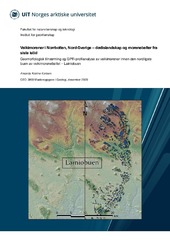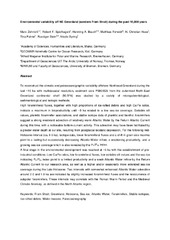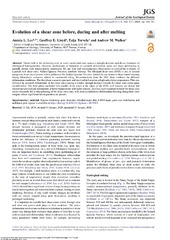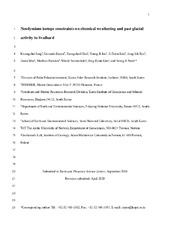Institutt for geovitenskap: Recent submissions
Now showing items 441-460 of 1121
-
Cyclostratigraphic age constraining for Quaternary sediments in the Makarov Basin of the western Arctic Ocean using manganese variability
(Journal article; Tidsskriftartikkel; Peer reviewed, 2019-09-26)The Quaternary paleoenvironmental history of the Arctic Ocean remains uncertain, mainly due to the limited chronological constraints, especially beyond the 14C dating limits of accelerator mass spectrometry (AMS). The difficulty in establishing reliable chronostratigraphies is mainly attributed to low sedimentation rates and diagenetic sediment changes, resulting in very poor preservation of ... -
Late Quaternary depositional and glacial history of the Arliss Plateau off the East Siberian margin in the western Arctic Ocean
(Journal article; Tidsskriftartikkel; Peer reviewed, 2019-12-19)Sedimentary stratigraphy and facies analysis along with seismostratigraphic and multibeam bathymetrydata are used to reconstruct the last glacial impact on the Arliss Plateau (AP) and attendant sedimen-tation in the adjacent Chukchi Basin (CB) in the western Arctic Ocean off the East Siberian margin.Sediment core ARA02B/16B-GC from the AP lower slope captures glacier-related depositional historyduring ... -
Comment to “Neoproterozoic magmatic arc systems of the central Ribeira belt, SE-Brazil, in the context of the West-Gondwana pre-collisional history: A review”
(Journal article; Tidsskriftartikkel; Peer reviewed, 2020-11-25) -
Geomorphology and surficial geology of the Femmilsjøen area, northern Spitsbergen
(Journal article; Tidsskriftartikkel; Peer reviewed, 2021-03-09)Climate change is amplified in the Arctic, and establishing baseline data for its current character is important. Here we present a map of the geomorphology of the Femmilsjøen area, Spitsbergen, northern Svalbard. The regional physiography is characterised by a low-relief, high elevation mountain plateau, its high-relief steep slopes, and low-relief coastal lowlands. The results indicate that glaciers ... -
Veikimorener i Norrbotten, Nord-Sverige – dødislandskap og morenebelter fra siste istid. Geomorfologisk tilnærming og GPR-profilanalyse av veikimorener innen den nordligste buen av veikimorenebeltet – Lainiobuen
(Master thesis; Mastergradsoppgave, 2020-12-30)Skandinavias glasiasjonshistorie er enda ikke kontinuerlig sammensatt for weichselistiden. I forhold til det fennoskandiske isskjoldet har nye studier avdekket alternative geokronologiske tolkninger for tidlig og midt weichsel i Nord-Sverige. Veikimorenelandskapet ble dannet over en stadial-interstadial syklus korrelert til tidlig weichsel av Lagerbäck (1988). Dette motstrides av moderne vitenskapelige ... -
Biomarker and isotopic composition of seep carbonates record environmental conditions in two Arctic methane seeps
(Journal article; Tidsskriftartikkel; Peer reviewed, 2021-02-12)Present-day activity of cold-seeps in the ocean is evident from direct observations of methane emanating from the seafloor, the presence of chemosynthetic organisms, or the quantification of gas concentrations in the water column and pore water solutes. Verifying past cold seep activity and biogeochemical characteristics is more challenging but may be reconstructed from proxy records of authigenic ... -
Environmental variability off NE Greenland (western Fram Strait) during the past 10,600 years
(Journal article; Tidsskriftartikkel; Peer reviewed, 2020-08-13)To reconstruct the climatic and paleoceanographic variability offshore Northeast Greenland during the last ~10 ka with multidecadal resolution, sediment core PS93/025 from the outermost North-East Greenland continental shelf (80.5°N) was studied by a variety of micropaleontological, sedimentological and isotopic methods. High foraminiferal fluxes, together with high proportions of ice-rafted debris ... -
Dinocyst stratigraphy of the Valanginian to Aptian succession (the Rurikfjellet and Helvetiafjellet formations) from Spitsbergen, Norway
(Journal article; Tidsskriftartikkel; Peer reviewed, 2020-02-11)In order to improve the understanding of how the high northern latitudes responded to the escalating warming which led to the middle Cretaceous super greenhouse climate, more temperature proxy records from the High Arctic are needed. One of the current obstacles in obtaining such records is poor age control on the Lower Cretaceous strata in the Boreal region. Here, we provide a biostratigraphic ... -
Passive seismic recording of cryoseisms in Adventdalen, Svalbard
(Journal article; Tidsskriftartikkel; Peer reviewed, 2021-01-20)A series of transient seismic events were discovered in passive seismic recordings from 2-D geophone arrays deployed at a frost polygon site in Adventdalen, Svalbard. These events contain a high proportion of surface wave energy and produce high-quality dispersion images using an apparent offset re-sorting and inter-trace delay minimisation technique to locate the seismic source, followed by ... -
Thermal Characterization of Pockmarks Across Vestnesa and Svyatogor Ridges, Offshore Svalbard
(Journal article; Tidsskriftartikkel, 2020-11-10)The Svalbard margin represents one of the northernmost gas hydrate provinces worldwide. Vestnesa Ridge (VR) and Svyatogor Ridge (SR) west of Svalbard are two prominent sediment drifts showing abundant pockmarks and sites of seismic chimney structures. Some of these sites at VR are associated with active gas venting and were the focus of drilling and coring with the seafloor‐deployed MARUM‐MeBo70 ... -
Evolution of a shear zone before, during and after melting
(Journal article; Tidsskriftartikkel; Peer reviewed, 2020-03-03)Partial melt in the deforming mid- or lower continental crust causes a strength decrease and drives formation of lithological heterogeneities. However, mechanisms of formation of syn-melt deformation zones and strain partitioning in partially molten rock remain poorly understood. We use field and microstructural observations to unravel the evolution of a partial melt shear zone, Seiland Igneous ... -
The Raunis section, central Latvia, revisited: first luminescence results and re-evaluation of a key Baltic States stratigraphic site
(Journal article; Tidsskriftartikkel; Peer reviewed, 2020-09-08)In interstadial deposits, sand interbeds gain limited consideration in comparison with organic sediments, and therefore tend to be underrepresented in paleoenvironmental reconstructions. The Raunis site, central-eastern Latvia, is an example where organic beds have already gained some attention and been used to understand the complex interactions between advance and retreat of the Scandinavian Ice ... -
Neodymium isotope constraints on chemical weathering and past glacial activity in Svalbard
(Journal article; Tidsskriftartikkel; Peer reviewed, 2020-05-15)<p>Neodymium (Nd) isotopes in leached authigenic components of marine sediments have been increasingly used as a tracer of past ocean-water masses. Despite the general assumption that the Nd isotopic composition of solutes released during chemical weathering fingerprints the source rocks on continents, preferential dissolution of easily dissolvable phases may result in significant deviations in Nd ... -
The role of shelf morphology on storm-bed variability and stratigraphic architecture, Lower Cretaceous, Svalbard
(Journal article; Tidsskriftartikkel; Peer reviewed, 2020-08-13)The dominance of isotropic hummocky cross‐stratification, recording deposition solely by oscillatory flows, in many ancient storm‐dominated shoreface–shelf successions is enigmatic. Based on conventional sedimentological investigations, this study shows that storm deposits in three different and stratigraphically separated siliciclastic sediment wedges within the Lower Cretaceous succession in ... -
Miocene Seep-Carbonates of the Northern Apennines (Emilia to Umbria, Italy): An Overview
(Journal article; Tidsskriftartikkel; Peer reviewed, 2021-01-28)The natural emission of methane-rich fluids from the seafloor, known as cold seepage, is a widespread process at modern continental margins. The studies on present-day cold seepages provide high-resolution datasets regarding the fluid plumbing system, biogeochemical processes in the sediment, seafloor seepage distribution and ecosystems. However, the long-term (hundreds of thousands to millions of ... -
Exhumation of the High‐Pressure Tsäkkok Lens, Swedish Caledonides: Insights From the Structural and White Mica 40Ar/39Ar Geochronological Record
(Journal article; Tidsskriftartikkel; Peer reviewed, 2020-06-12)Integrated structural, geochemical, and geochronological investigations were conducted on metasedimentary rocks in the eclogite-bearing Tsäkkok Lens of the Seve Nappe Complex (Scandinavian Caledonides) to resolve its exhumation history. Three deformation events are defined. D1 is likely related to the prograde to peak-metamorphic stages, represented by a locally preserved S1. D2 resulted in vertical ... -
Feasibility of using the P-Cable high-resolution 3D seismic system in detecting and monitoring CO2 leakage
(Journal article; Tidsskriftartikkel; Peer reviewed, 2021-01-23)The P-Cable technology is an acquisition principle for high-resolution and ultra-high-resolution 3D seismic data. Many 3D seismic datasets have been acquired over the last decade, but the application in time-lapse studies for monitoring of CO2 storage is a new and intriguing topic. High-resolution 3D (HR3D) seismic has the potential to detect and monitor CO2 leakage at carbon capture and storage ... -
Exceptions to bed-controlled ice sheet flow and retreat from glaciated continental margins worldwide
(Journal article; Tidsskriftartikkel; Peer reviewed, 2021-01-13)Projections of ice sheet behavior hinge on how ice flow velocity evolves and the extent to which marine-based grounding lines are stable. Ice flow and grounding line retreat are variably governed by the coupling between the ice and underlying terrain. We ask to what degree catchment-scale bed characteristics determine ice flow and retreat, drawing on paleo-ice sheet landform imprints from 99 sites ... -
Homogeneous glacial landscapes can have high local variability of strontium isotope signatures: Implications for prehistoric migration studies
(Journal article; Tidsskriftartikkel; Peer reviewed, 2021-01-15)Increasingly, strontium (Sr) isotopes are used to distinguish locals and migrants in prehistoric studies, by measuring <sup>87</sup>Sr/<sup>86</sup>Sr in human remains and comparing these values to the distribution of the bioavailable <sup>87</sup>Sr/<sup>86</sup>Sr in the study area, often in surface water. However, it has recently been shown that agricultural lime can have a substantial impact on ... -
Multiproxy paleoceanographic study from the western Barents Sea reveals dramatic Younger Dryas onset followed by oscillatory warming trend
(Journal article; Tidsskriftartikkel; Peer reviewed, 2020-09-24)The Younger Dryas (YD) is recognized as a cool period that began and ended abruptly during a time of general warming at the end of the last glacial. New multi-proxy data from a sediment gravity core from Storfjordrenna (western Barents Sea, 253 m water depth) reveals that the onset of the YD occurred as a single short-lived dramatic environment deterioration, whereas the subsequent warming was ...


 English
English norsk
norsk


















